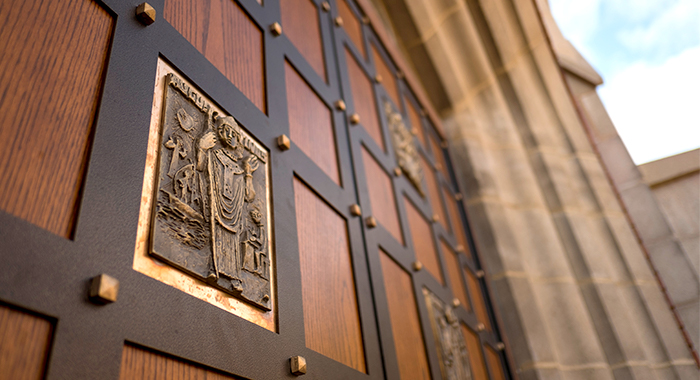Making an Entrance Takes on New Meaning
A demolition prompted a new design element at Old St. Joseph Church.
When the Rev. James Neilson, O.Praem., ’88 became pastor of the St. Norbert College Parish in 2015, he noticed cracking in the structure that once served as protection for the front doors of the church. The solution was simple; tear it down. A different concern arose.
“In the late 1990s, millions of dollars were spent building an atrium,” explains the Rev. Andrew Ciferni, O.Praem., ’64, director of the Center for Norbertine Studies and former parochial vicar at the college parish. “You have to go by the baptismal font to go in the church. So now, somebody coming off the parking lot sees this [now open] area and asks, ‘Is this the front door?’ Some were tempted to say, ‘Let’s make it a front door again,’ which would have been difficult because we have the Blessed Sacrament.”
Prior to the redesign, the tabernacle was kept in a separate chapel. It was moved into the church and placed in front of a newly constructed wall that prevents a clear pathway from the front doors. The doors do not have handles, so there is no access from outside. Fire codes require the doors, which can be opened from the inside, to remain.
Ciferni teamed with Brian Netzel and Michael Babbitts of Performa Inc. for a door redesign; he chose the holy doors of the papal basilicas in Rome as inspiration. The wood doors were first refinished. Ritchie Metal Works Corp. of De Pere created custom studs and grill work. Bronze plaques featuring the work of the late German artist Egino Weinert were placed within the grill on the door. The plaques depict St. Norbert, St. Augustine, the Holy Spirit, Pentecost, the Holy Family, St. John the Baptist, St. Mary Magdalene, St. Monica and Blessed Hermann Joseph.
“Augustine and Norbert were easy choices,” says Ciferni. “The Holy Family is what we hope our students come from and what we hope to lead them back to. John the Baptist is a big patron of reform.”
Blessed Hermann Joseph, a 13th-century Norbertine from Germany, was selected because he is the patron of children and students.
“There is a story about him when he was a little boy going back and forth to school,” explains Ciferni. “He had an apple. He visited one of the churches in Cologne where he saw the child Jesus sitting on Mary’s lap, a statue. He offered the child an apple and the child came to life and took the apple.”
St. Monica, the mother of St. Augustine, and St. Mary Magdalene were selected as female models of holiness. St. Mary Magdalene is shown washing Jesus’ feet on the plaque, which is not accurate. Pope Gregory the Great fused three women into Mary Magdalene. The Catholic church corrected the error in 1969, but artistic images continue to depict Mary Magdalene washing Jesus’ feet with her hair.
Ciferni expects the raised space in front of the doors to be used in ministry.
“It’s no longer the ‘front door,’ it’s a completely new design,” he says. “I have an architect friend who says, ‘If you design something well, you will think of ways to use it that you didn’t think of when you designed it.’ I think we’ve done that with this space. I can see it being used for Palm Sunday, the Easter Vigil and other special occasions.
“Somebody also said this will be a prime site for wedding pictures,” he adds.
The space in front of the new doors has already provided the backdrop for a marriage proposal. The couple met as students at St. Norbert, and recently returned to the college during a night out.
“They came here and he knelt down and asked, ‘Will you marry me?’ ” explains Ciferni. “They want to get married here. You want to create something that draws people to it. The response has been fantastic.”
Oct. 3, 2017












